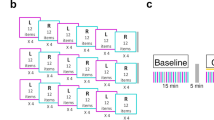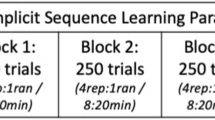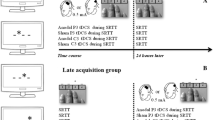Abstract
Motor imagery (MI), the mental rehearsal of motor tasks, has promise as a therapy in post-stroke rehabilitation. The potential effectiveness of MI is attributed to the facilitation of plasticity in numerous brain regions akin to those recruited for physical practice. It is suggested, however, that MI relies more heavily on regions commonly affected post-stroke, including left hemisphere parietal regions involved in visuospatial processes. However, the impact of parietal damage on MI-based skill acquisition that underlies rehabilitation remains unclear. Here, we examine the contribution of the left inferior parietal lobule (IPL) to MI using inhibitory transcranial magnetic stimulation (TMS) and an MI-based implicit sequence learning (ISL) paradigm. Participants (N = 27) completed the MI-based ISL paradigm after receiving continuous theta burst stimulation to the left IPL (TMS), or with the coil angled away from the scalp (sham). Reaction time differences (dRT) and effect sizes between implicit and random sequences assessed success of MI-based learning. Mean dRT for the sham group was 36.1 ± 28.2 ms (d = 0.71). Mean dRT in the TMS group was 7.7 ± 38.5 ms (d = 0.11). These results indicate that inhibition of the left IPL impaired MI-based learning. We conclude that the IPL and likely the visuospatial processes it mediates are critical for MI performance and thus MI-based skill acquisition or learning. Ultimately, these findings have implications for the use of MI in post-stroke rehabilitation.




Similar content being viewed by others
References
Annett J (1995) Motor imagery: perception or action? Neuropsychologia 33:1395–1417
Behrmann M (2004) Parietal cortex and attention. Curr Opin Neurobiol 14:212–217. doi:10.1016/j.conb.2004.03.012
Bolognini N, Ro T (2010) Transcranial magnetic stimulation: disrupting neural activity to alter and assess brain function. J Neurosci 30:9647–9650. doi:10.1523/JNEUROSCI.1990-10.2010
Braun S, Kleynen M, Schols J et al (2008) Using mental practice in stroke rehabilitation: a framework. Clin Rehabil 22:579–591. doi:10.1177/0269215508090066
Buch ER, Modir Shanechi A, Fourkas AD et al (2012) Parietofrontal integrity determines neural modulation associated with grasping imagery after stroke. Brain 135:596–614. doi:10.1093/brain/awr331
Burianová H, Marstaller L, Sowman P et al (2013) Multimodal functional imaging of motor imagery using a novel paradigm. NeuroImage 71:50–58. doi:10.1016/j.neuroimage.2013.01.001
Chambers C, Payne J, Mattingley J (2007) Parietal disruption impairs reflexive spatial attention within and between sensory modalities. Neuropsychologia 45:1715–1724. doi:10.1016/j.neuropsychologia.2007.01.001
Chen W-HH, Mima T, Siebner HR et al (2003) Low-frequency rTMS over lateral premotor cortex induces lasting changes in regional activation and functional coupling of cortical motor areas. Clin Neurophysiol 114:1628–1637
Cooke DF, Taylor CS, Moore T, Graziano MS (2003) Complex movements evoked by microstimulation of the ventral intraparietal area. Proc Natl Acad Sci USA 100:6163–6168. doi:10.1073/pnas.1031751100
Corbetta M, Shulman G (2002) Control of goal-directed and stimulus-driven attention in the brain. Nat Rev Neurosci 3:201–215. doi:10.1038/nrn755
Culham J, Cavina-Pratesi C, Singhal A (2006) The role of parietal cortex in visuomotor control: what have we learned from neuroimaging? Neuropsychologia 44:2668–2684. doi:10.1016/j.neuropsychologia.2005.11.003
de Vries P, de Jong B, Bohning D et al (2009) Changes in cerebral activations during movement execution and imagery after parietal cortex TMS interleaved with 3T MRI. Brain Res 1285:58–68. doi:10.1016/j.brainres.2009.06.006
Destrebecqz A, Peigneux P, Laureys S et al (2005) The neural correlates of implicit and explicit sequence learning: interacting networks revealed by the process dissociation procedure. Learn Mem 12:480–490. doi:10.1101/lm.95605
Doyon J, Benali H (2005) Reorganization and plasticity in the adult brain during learning of motor skills. Curr Opin Neurobiol 15:161–167. doi:10.1016/j.conb.2005.03.004
Gallivan JP, Culham JC (2015) Neural coding within human brain areas involved in actions. Curr Opin Neurobiol 33:141–149. doi:10.1016/j.conb.2015.03.012
Goschke T, Bolte A (2012) On the modularity of implicit sequence learning: independent acquisition of spatial, symbolic, and manual sequences. Cogn Psychol 65:284–320. doi:10.1016/j.cogpsych.2012.04.002
Hétu S, Grégoire M, Saimpont A et al (2013) The neural network of motor imagery: an ALE meta-analysis. Neurosci Biobehav Rev 37:930–949. doi:10.1016/j.neubiorev.2013.03.017
Hikosaka O, Nakamura K, Sakai K, Nakahara H (2002) Central mechanisms of motor skill learning. Curr Opin Neurobiol 12:217–222
Hilgetag C, Théoret H, Pascual-Leone A (2001) Enhanced visual spatial attention ipsilateral to rTMS-induced “virtual lesions” of human parietal cortex. Nat Neurosci 4:953–957. doi:10.1038/nn0901-953
Huang Y-ZZ, Edwards MJ, Rounis E et al (2005) Theta burst stimulation of the human motor cortex. Neuron 45:201–206. doi:10.1016/j.neuron.2004.12.033
Jeannerod M (1995) Mental imagery in the motor context. Neuropsychologia 33:1419–1432
Jeannerod M (2001) Neural simulation of action: a unifying mechanism for motor cognition. NeuroImage 14:S103–S109. doi:10.1006/nimg.2001.0832
Johansson B (2011) Current trends in stroke rehabilitation. A review with focus on brain plasticity: stroke rehabilitation. Acta Neurol Scand 123:147–159. doi:10.1111/j.1600-0404.2010.01417.x
Kawamichi H, Kikuchi Y, Endo H et al (1998) Temporal structure of implicit motor imagery in visual hand-shape discrimination as revealed by MEG. NeuroReport 9:1127–1132
Kelley K, Preacher K (2012) On effect size. Psychol Methods 17:137–152. doi:10.1037/a0028086
Kitadono K, Humphreys G (2011) Neuropsychological evidence for an interaction between endogenous visual and motor-based attention. Neurocase 17:323–331. doi:10.1080/13554794.2010.509322
Kleim J, Kleim E, Cramer S (2007) Systematic assessment of training-induced changes in corticospinal output to hand using frameless stereotaxic transcranial magnetic stimulation. Nat Protoc 2:1675–1684. doi:10.1038/nprot.2007.206
Kraeutner S, Gionfriddo A, Bardouille T, Boe S (2014) Motor imagery-based brain activity parallels that of motor execution: evidence from magnetic source imaging of cortical oscillations. Brain Res 1588:81–91. doi:10.1016/j.brainres.2014.09.001
Kraeutner S, MacKenzie L, Westwood D, Boe S (2015) Characterising skill acquisition through motor imagery with no prior physical practice. J Exp Psychol. doi:10.1037/xhp0000148
Lebon F, Lotze M, Stinear C, Byblow W (2012) Task-dependent interaction between parietal and contralateral primary motor cortex during explicit versus implicit motor imagery. PLoS ONE 7:e37850. doi:10.1371/journal.pone.0037850
López-Alonso V, Cheeran B, Rio-Rodriguez D, Fernández-Del-Olmo M (2014) Inter-individual variability in response to non-invasive brain stimulation paradigms. Brain Stimul 7:372–380 doi:10.1016/j.brs.2014.02.004
Malouin F, Richards C, Jackson P et al (2007) The kinesthetic and visual imagery questionnaire (KVIQ) for assessing motor imagery in persons with physical disabilities: a reliability and construct validity study. J Neurol Phys Ther 31:20–29. doi:10.1097/01.NPT.0000260567.24122.64
Marvel C, Turner B, O’Leary D et al (2007) The neural correlates of implicit sequence learning in schizophrenia. Neuropsychology 21:761. doi:10.1037/0894-4105.21.6.761-777
McInnes K, Friesen C, Boe S (2015) Specific brain lesions impair explicit motor imagery ability: a systematic review of the evidence. Arch Phys Med Rehabil 15:620–626. doi:10.1016/j.apmr.2015.07.012
Miyawaki Y, Shinozaki T, Okada M (2012) Spike suppression in a local cortical circuit induced by transcranial magnetic stimulation. J Comput Neurosci 33:405–419. doi:10.1007/s10827-012-0392-x
Moran A, Guillot A, MacIntyre T, Collet C (2012) Re-imagining motor imagery: building bridges between cognitive neuroscience and sport psychology: re-imagining motor imagery. Br J Psychol 103:224–247. doi:10.1111/j.2044-8295.2011.02068.x
Nyffeler T, Cazzoli D, Wurtz P et al (2008) Neglect-like visual exploration behaviour after theta burst transcranial magnetic stimulation of the right posterior parietal cortex. Eur J Neurosci 27:1809–1813. doi:10.1111/j.1460-9568.2008.06154.x
Nyffeler T, Cazzoli D, Hess CW, Müri RMM (2009) One session of repeated parietal theta burst stimulation trains induces long-lasting improvement of visual neglect. Stroke 40:2791–2796. doi:10.1161/STROKEAHA.109.552323
Oberman L, Edwards D, Eldaief M, Pascual-Leone A (2011) Safety of theta burst transcranial magnetic stimulation: a systematic review of the literature. J Clin Neurophysiol 28:67–74. doi:10.1097/WNP.0b013e318205135f
Oldfield RC (1971) The assessment and analysis of handedness: the Edinburgh inventory. Neuropsychologia 9:97–113. doi:10.1016/0028-3932(71)90067-4
Rizzolatti G, Matelli M (2003) Two different streams form the dorsal visual system: anatomy and functions. Exp Brain Res 153:146–157. doi:10.1007/s00221-003-1588-0
Rorden C, Karnath H-O (2004) Using human brain lesions to infer function: a relic from a past era in the fMRI age? Nat Rev Neurosci 5:813–819. doi:10.1038/nrn1521
Rossi S, Hallett M, Rossini P, Pascual-Leone A (2009) Safety, ethical considerations, and application guidelines for the use of transcranial magnetic stimulation in clinical practice and research. Clin Neurophysiol 120:2008–2039. doi:10.1016/j.clinph.2009.08.016
Ruff CC, Driver J, Bestmann S (2009) Combining TMS and fMRI: from “virtual lesions” to functional-network accounts of cognition. Cortex 45:1043–1049. doi:10.1016/j.cortex.2008.10.012
Rushworth M, Krams M, Passingham R (2001) The Attentional Role of the Left Parietal Cortex: the distinct lateralization and localization of motor attention in the human brain. J Cogn Neurosci 13:698–710. doi:10.1162/089892901750363244
Rushworth MF, Johansen-Berg H, Göbel S, Devlin J (2003) The left parietal and premotor cortices: motor attention and selection. NeuroImage 20:S89–S100. doi:10.1016/j.neuroimage.2003.09.011
Rüsseler J, Hennighausen E, Rösler F (2001) Response anticipation processes in the learning of a sensorimotor sequence. J Psychophysiol 15:95–105. doi:10.1027//0269-8803.15.2.95
Sack AT (2006) Transcranial magnetic stimulation, causal structure-function mapping and networks of functional relevance. Curr Opin Neurobiol 16:593–599. doi:10.1016/j.conb.2006.06.016
Sharma N, Pomeroy V, Baron J-C (2006) Motor imagery a backdoor to the motor system after stroke? Stroke 37:1941–1952. doi:10.1161/01.STR.0000226902.43357.fc
Sharma N, Baron J-C, Rowe J (2009) Motor imagery after stroke: relating outcome to motor network connectivity. Ann Neurol 66:604–616. doi:10.1002/ana.21810
Sirigu A, Duhamel JR, Cohen L et al (1996) The mental representation of hand movements after parietal cortex damage. Science 273:1564–1568
Stinear C, Byblow W, Steyvers M et al (2006) Kinesthetic, but not visual, motor imagery modulates corticomotor excitability. Exp Brain Res 168:157–164. doi:10.1007/s00221-005-0078-y
Tzvi E, Münte T, Krämer U (2014) Delineating the cortico-striatal-cerebellar network in implicit motor sequence learning. Neuroimage 94:222–230. doi:10.1016/j.neuroimage.2014.03.004
Ungerleider LG, Doyon J, Karni A (2002) Imaging brain plasticity during motor skill learning. Neurobiol Learn Mem 78:553–564
Vandenberghe R, Molenberghs P, Gillebert C (2012) Spatial attention deficits in humans: the critical role of superior compared to inferior parietal lesions. Neuropsychologia 50:1092–1103. doi:10.1016/j.neuropsychologia.2011.12.016
Wagner TA, Zahn M, Grodzinsky AJ, Pascual-Leone A (2004) Three-dimensional head model simulation of transcranial magnetic stimulation. IEEE Trans Biomed Eng 51:1586–1598. doi:10.1109/TBME.2004.827925
Wohldmann EL, Healy AF, Lyle BEJ (2007) Pushing the limits of imagination: mental practice for learning sequences. J Exp Psychol Learn Mem Cogn 33:254–261. doi:10.1037/0278-7393.33.1.254
Wulf G, Shea C, Lewthwaite R (2010) Motor skill learning and performance: a review of influential factors: motor skill learning and performance. Med Educ 44:75–84. doi:10.1111/j.1365-2923.2009.03421.x
Zhang H, Xu L, Zhang R et al (2012) Parallel alterations of functional connectivity during execution and imagination after motor imagery learning. PLoS ONE 7:e36052. doi:10.1371/journal.pone.0036052
Acknowledgments
This work was supported by funding from the Heart and Stroke Foundation of Canada and Natural Sciences and Engineering Research Council (NSERC) awarded to SB. SK is supported by training awards from NSERC and the Nova Scotia Research and Innovation Graduate Scholarship.
Author information
Authors and Affiliations
Corresponding author
Electronic supplementary material
Below is the link to the electronic supplementary material.
221_2015_4472_MOESM1_ESM.tif
Supplementary Figure 1. Validation of the target site (IPL) in a participant using their anatomical MRI. The left panel shows target placement for localization of the hot spot and inferior parietal lobe (IPL) on a template brain, with localization of the IPL via MNI coordinates on a participants anatomical MRI shown in the middle and right panels.(TIFF 1073 kb)
Rights and permissions
About this article
Cite this article
Kraeutner, S.N., Keeler, L.T. & Boe, S.G. Motor imagery-based skill acquisition disrupted following rTMS of the inferior parietal lobule. Exp Brain Res 234, 397–407 (2016). https://doi.org/10.1007/s00221-015-4472-9
Received:
Accepted:
Published:
Issue Date:
DOI: https://doi.org/10.1007/s00221-015-4472-9




